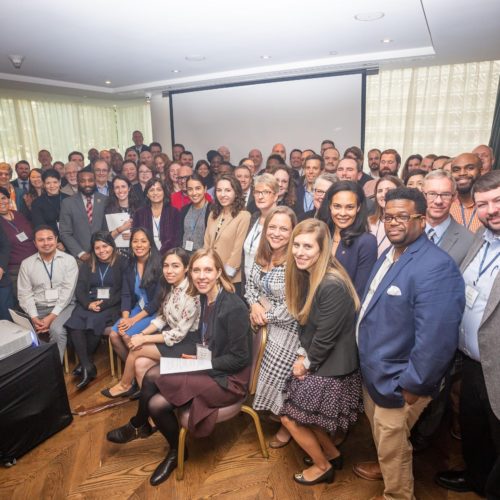The American Talent Initiative’s Fall 2017 Data Working Group Meeting
By Emily Schwartz
November 15, 2017
This post originally appeared on the Ithaka S+R blog.
Reading Time: 3 minutes

In early October, the American Talent Initiative hosted main points of contact from member institutions in Washington, DC, for a Strategic Support Meeting, sharing research and connecting members around promising strategies for enhancing access and success for lower-income students. Later in the month, the American Talent Initiative held another convening, also in Washington DC, for the institutional research contacts of ATI member institutions. The meeting, run by Ithaka S+R and The Aspen Institute, had three primary goals: 1) to deepen relationships and form networks in order to generate momentum for our shared efforts to expand access and opportunity, 2) for ATI members to weigh-in on the data collection and reporting strategy of the initiative, and to share relevant challenges and insights to enhance future ATI data collection and reporting efforts, and 3) for ATI members to share best practices about data collection, reporting, and data-driven decision-making. Data collections from each ATI member institution is a key tool for tracking progress toward the initiative’s collective goal: adding an additional 50,000 low- and moderate-income students at top-performing colleges and universities by 2025.
Meeting Agenda
The one-day meeting began with an introductory session that provided an overview of the ATI work to-date. The American Talent Initiative has grown to 86 members in recent months, so for some representatives this was their first substantive touch-point with their ATI colleagues and ATI staff. The introductory session brought everyone up to speed, provided context for conversations to come throughout the day, and shared some of the same framing presented at the Strategic Support Meeting.
Following the introductory session, the next session focused on the reflections of ATI staff and members on the challenges and successes of the Spring/Summer 2017 ATI data collection process. Each year, ATI members are asked to submit data on a variety of variables surrounding enrollment and performance (e.g. Pell enrollment, 4- and 6-year graduation rates, and first-year retention rates). For 2017, the majority of members have already completed this process, and this session highlighted the data aggregation process and common submission errors. Meeting participants were then asked to discuss the major challenges they faced in providing the ATI data, and to share any insights the collection generated about their campus data processes or strategic priorities.
The next session presented an opportunity for participants to weigh in on the direction of future ATI data collections, particularly the possible addition of new data elements. Participants weighed the pros and cons of additional metrics to collect (e.g. counts and/or graduation and retention rates of Pell recipients by: race/ethnicity, first-gen status, and gender) concluding that, while the proposed metrics would provide more nuanced information as members work toward collective goals, additional collection would present more work for often under-staffed institutional research offices. Following a discussion of the proposed metrics, participants dove deeper into discussing a standard, comparable definition of “moderate-income,” and possible approaches for obtaining more detailed data on the income distribution of member institutions. Doing so remains a priority for ATI members and staff moving forward.
After lunch, select presenters from ATI member institutions discussed the strategic role of IR on their campuses as part of a moderated panel discussion. Then, participants broke into groups to participate in a peer consultancy exercise, where volunteers presented specific challenges they face at their institutions, soliciting feedback from their peers on effective strategies to overcome those challenges.
Following the peer exercise, participants then worked in advisory groups, choosing from among topics identified by the full group, such as the defining the ATI research agenda, determining a shared definition of “moderate-income,” and interpreting the new federal financial aid data regulations. These conversations allowed participants to go a little deeper into a subject of particular interest. The advisory groups shared their written recommendations on next steps with ATI staff. Following the meeting, participants were given the opportunity to join advisory groups that will continue to meet virtually in the coming months.
The day concluded with a panel discussion on post-graduation outcomes, moderated by Mamie Voight of the Institute for Higher Education Policy. Panelists from ATI member institutions shared the work they are doing to track and report on students’ careers, earnings, and well-being after they leave their institutions. Jeff Strohl, Director of Research at Georgetown’s Center on Education and the Workforce, provided insights from an outside research perspective.
Key Takeaways
In reflecting on the meeting, some key takeaways emerge:
- Institutional research offices are often understaffed, making data collection beyond the scope of what institutions are regularly collecting and reporting on very challenging. In many cases, data is housed in multiple offices on campus, making it more difficult for institutional researchers to obtain certain metrics (e.g., financial aid data). Since institutions operate in a variety of different contexts, ATI staff, in consultation with ATI members, may request additional data collection metrics on an optional basis.
- ATI staff, in close consultation with ATI members, should continue to work toward a comparable, standardized definition of “moderate-income.” Currently, ATI uses counts of Pell recipients to approximate the number of low- and moderate-income students on a campus, as Pell data is comparable across institutions and publicly available for almost all US colleges and universities. Participants understood the value of using Pell data as a signal for the numbers of low- or moderate-income at an institution, but agreed that the number of Pell recipients enrolled provides an incomplete view of the institution’s income distribution.
- Participants appreciated the opportunity to network with colleagues at other institutions, and many indicated that they learned something new from a peer that will influence their work, especially their work aligned with the access and success goals of ATI, on their campuses.
- There was also consensus that the participants of this meeting should work more closely with the main points of contact and others championing ATI work on their campuses. It would also be beneficial to hold convenings that bring people together across their various ATI roles.
The ATI team is actively preparing for the February 2018 Presidential Roundtable, which brings together the presidents of member institutions to discuss the goals, progress, and next steps of the initiative. We look forward to sharing insights from that meeting, as well as the progress of ATI work more broadly, in the months to come.




